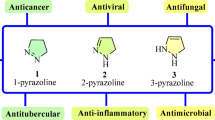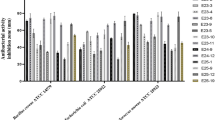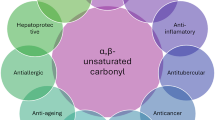Abstract
Although, the structure of oligomycin A (1) was confirmed by spectroscopic and chemical evaluations, some crystallographic data cast doubt on the originally adopted structure of the side 2-hydroxypropyl moiety of this antibiotic. It was suggested that the side chain of the oligomycin is enol-related (2-hydroxy-1-propenyl). To clarify this matter we synthesized and evaluated 33-dehydrooligomycin A (2) prepared by the Kornblum oxidation of 33-O-mesyloligomycin A (3) by dimethyl sulfoxide. NMR data for 33-dehydrooligomycin (2) and results of quantum chemical calculations have shown that this derivative exists in the keto rather than in the enol tautomer 2a. The in vitro antimicrobial activity of 2 was approximately two times weaker in comparison with oligomycin A against Streptomyces fradiae ATCC-19609 and reference Candida spp. strains and similar activity against certain filamentous fungi. The docking binding estimate of 2 with FOF1ATP synthase showed a slight decrease in binding affinity for 2 when compared with oligomycin A; that correlated with its activity against S. fradiae ATCC 19609 that is supersensitive to oligomycin A. The in vitro antiproliferative activities of 2 are also discussed.
Similar content being viewed by others
Log in or create a free account to read this content
Gain free access to this article, as well as selected content from this journal and more on nature.com
or
References
Smith, R. M., Peterson, W. H. & Mccoy, E. Oligomycin, a new antifungal antibiotic. Antibiot. Chemother. 4, 962–970 (1954).
Symersky, J., Osowski, D., Walters, D. E. & Mueller, D. M. Oligomycin frames a common drug-binding site in the ATP synthase. Proc. Natl Acad. Sci. USA 109, 13961–13965 (2012).
Carter, G. T. Structure determination of olygomycin A and C. J. Org. Chem. 51, 4264–4271 (1986).
Morris, G. A. & Richards, M. S. Concerted use of two-dimensional NMR techniques in the Ab initio assignment of complex spectra: complete proton and carbon-13 assignment of oligomycin A. Magn. Res. Chem. 23, 676–683 (1985).
Evans, D. A., Rieger, D. L., Jones, T. K. & Kaldor, S. W. Assignment of stereochemistry in the oligomycin, rutamycin, cytovaricin family antibiotics. Asymmetric synthesis of the rutamycin spiroketal synthon. J. Org. Chem. 55, 6260–6268 (1990).
Panek, J. S. & Jain, N. F. Total synthesis of rutamycin B and oligomycin C. J. Org. Chem. 66, 2747–2756 (2001).
Yang, P. W. et al. Oligomycin A and C, major secondary metabolites isolated from the newly isolated strain Streptomyces diastaticus. Folia Microbiol. 55, 10–16 (2010).
Palmer, R. A. & Potter, B. S. X-ray Structures and absolute configurations of the antibiotics oligomycins A, B and C: inhibitors of ATP synthase. J. Chem. Cryst. 38, 243–253 (2008).
Green, R. C. E. et al. A comparative study of the single crystal X-ray determination and molecular modelling of the binding of oligomycin to ATP synthase. Comput. Biol. Chem. 33, 189–195 (2009).
Palmer, R. A., Ladd, M., Howlin, B. & Lisgarten, D. R. X-ray structures of two forms of the antibiotic oligomycin A: an inhibitor of ATP synthase. Future Med. Chem. 5, 881–893 (2013).
Lysenkova, L. N. et al. Synthesis and anti-actinomycotic activity of thiocyanato derivative of oligomycin A modified in the side propanol residue. Macroheterocycles 8, 424–428 (2015).
Lysenkova, L. N. et al. Synthesis and cytotoxicity of oligomycin A derivatives modified in the side chain. Bioorg. Med. Chem. 21, 2918–2924 (2013).
Lysenkova, L. N. et al. Synthesis of 33-(R,S-Bromo-33-deoxyoligomycin A. Macroheterocycles 9, 307–313 (2016).
Omelchuk, O. A. et al. Synthesis and biological activity of 2,3,16,17,18,19-hexahydrooligomycin A. Macroheterocycles 9, 453–461 (2016).
Berdy, J., Aszalos, A., Bostian, M. & McNitt, K. CRC Handbook of Antibiotic Compounds IV (2) 319 CRC Press, FL, USA, (1980).
Kornblum, N., Jones, W. J. & Anderson, G. J. A new selective method of oxidation. The conversion of alkyl halides and alkyl tosylates to aldehydes. J. Am. Chem. Soc. 81, 1413–1414 (1959).
Krapcho, A. P. Dimethyl sulfoxide. e-EROS Encyclopedia of Reagents for Organic Synthesis doi:10.1002/047084289X.rd373.pub2 (2004).
Lysenkova, L. N. et al. Study on retroaldol degradation products of antibiotic oligomycin A. J. Antibiot. 67, 153–158 (2014).
Stewart, J. J. P. Optimization of parameters for semiempirical methods V: modification of NDDO approximations and application to 70 elements. J. Mol. Model. 13, 1173–1213 (2007).
Stephens, P. J., Devlin, F. J., Chabalowski, C. F. & Frisch, M. J. Ab initio calculation of vibrational absorption and circular dichroism spectra using density functional force fields. J. Phys. Chem. 98, 11623–11627 (1994).
Clinical and Laboratory Standards Institute (CLSI) Reference Method for Broth Dilution Antifungal Susceptibility Testing of Yeasts third ednCLSI document M27-A3 (CLSI, Wayne, PA, USA, (2008).
Clinical and Laboratory Standards Institute (CLSI) Reference Method for Broth Dilution Antifungal Susceptibility Testing of Filamentous fungi 2nd ednCLSI document M38-A2 (CLSI, Wayne, PA, USA, (2008).
Alekseeva, M. G., Elizarov, S. M., Bekker, O. B., Lubimova, I. K. & Danilenko, V. N. F0 F1 ATP synthase of Streptomycetes: modulation of activity and oligomycin resistance by protein Ser/Thr kinases Biochemistry (Moscow). Suppl. Series A Membrane Cell Biol. 3, 16–23 (2009).
Alekseeva, M. G. et al. FoF1-ATP synthase of Streptomyces fradiae ATCC 19609: structural, biochemical, and functional characterization. Biochemistry (Mosc.) 80, 296–309 (2015).
Shchekotikhin, A. E. et al. The first series of 4,11-bis[(2-aminoethyl)amino]anthra[2,3-b]furan-5,10-diones: synthesis and anti-proliferative characteristics. Eur. J. Med. Chem. 46, 423–428 (2011).
Abagyan, R., Totrov, M. & Kuznetsov, D. ICM, a new method for protein modeling and design: applications to docking and structure prediction from the distorted native conformation. J. Comput. Chem. 15, 488–506 (1994).
Arnautova, Y. A., Jagielska, A. & Scheraga, H. A. A new force field (ECEPP-05) for peptides, proteins, and organic molecules. J. Phys. Chem. B 110, 5025–5044 (2006).
Halgren, T. A. Merck molecular force field. I. Basis, form, scope, parameterization, and performance of MMFF94. J. Comp. Chem 17, 490–519 (1996).
Totrov, M. & Abagyan, R. in Drug-Receptor Thermodynamics: Introduction and Applications (ed. R. B. Raffa, 603–624 (John Wiley & Sons, (2001).
Wesson, L. & Eisenberg, D. Atomic solvation parameters applied to molecular dynamics of proteins in solution. Protein Sci. 1, 227–235 Cambridge University Press, (1992).
Acknowledgements
This study was supported by grants by the Russian Science Foundation (agreement no. 15-15-00141). We thank YN Luzikov for the help with NMR, NM Maliutina for HPLC and EN Bichkova (Gause Institute of New Antibiotics) for IR and UV analyses.
Author information
Authors and Affiliations
Corresponding author
Ethics declarations
Competing interests
The authors declare no conflict of interest.
Additional information
Supplementary Information accompanies the paper on The Journal of Antibiotics website
Supplementary information
Rights and permissions
About this article
Cite this article
Lysenkova, L., Saveljev, O., Grammatikova, N. et al. Verification of oligomycin A structure: synthesis and biological evaluation of 33-dehydrooligomycin A. J Antibiot 70, 871–877 (2017). https://doi.org/10.1038/ja.2017.48
Received:
Revised:
Accepted:
Published:
Issue date:
DOI: https://doi.org/10.1038/ja.2017.48
This article is cited by
-
ATP dynamics as a predictor of future podocyte structure and function after acute ischemic kidney injury in female mice
Nature Communications (2024)
-
Key areas of antibiotic research conducted at the Gause Institute of New Antibiotics
Russian Chemical Bulletin (2024)



